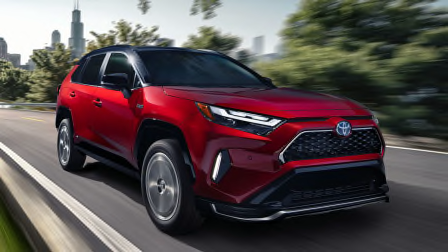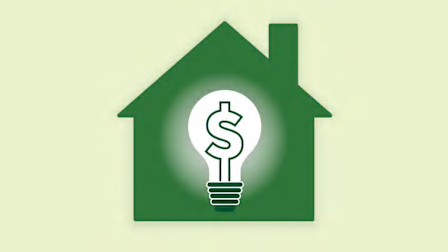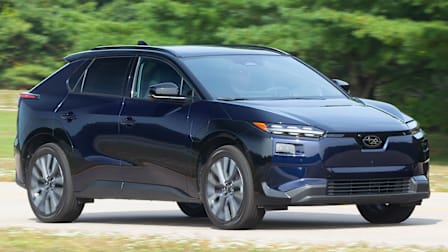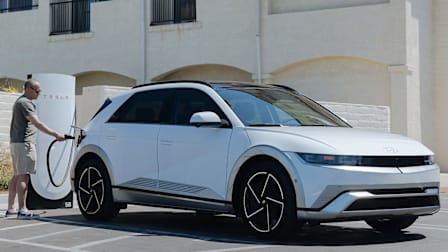Some Costco, Ikea, Target, and Walmart Stores Now Offer EV Charging Stations
But a Consumer Reports analysis finds they all could put a lot more of them in their parking lots
The Ikea in Red Hook neighborhood in Brooklyn, N.Y., is a blue and yellow beacon that, from the right angle, almost appears to float in New York Harbor just behind it. Shoppers can arrive by ferry, taxi, subway, or bus, or they can drive there—as typical suburban Ikeas do, this one also has a vast parking lot. And yet the parking facility represents what the Swedes might call “pågående arbete”—a work in progress. Of the 1,400 parking spots, only four are equipped with electric vehicle (EV) chargers.
And that’s a problem, as the clock runs down on the Biden administration’s ambitious target to have EVs make up 50 percent of new car sales by 2030. According to recent federal data, 1.25 million public chargers are needed to meet projected demand, and presently less than a tenth of those chargers have been installed.
The lack of ready access to chargers is a big concern for EV owners, according to a fall 2022 nationally representative Consumer Reports survey (PDF) of 943 people in the U.S. who have one of the vehicles. It found that charging logistics—including the scarcity of public charging—was one of the most common worries they had before purchasing their car (second only to range anxiety), and the most common problem they had once they owned the vehicle.
Given the enormous need to build out an EV charging infrastructure, the private sector—and especially retail stores—could and should be a key player.
Physical locations—particularly big-box stores like Ikea, fast-food chains, and other retailers in shopping centers with vast parking lots—make excellent candidates for helping build our electric future for several reasons. They are omnipresent in the U.S. and are often centrally located near highways. Huge numbers of Americans arrive by car to shop or dine at them. And while some of those locations offer fast chargers, allowing car owners to fully recharge while doing their shopping, even lower-powered options let people add a few more miles each time they stop to do some shopping.
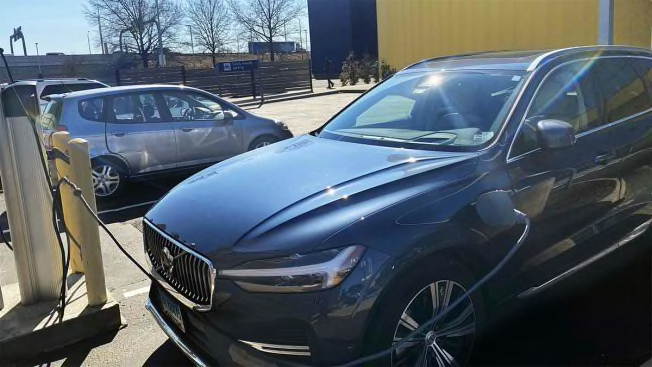
Photo: Consumer Reports Photo: Consumer Reports
Big-Box Leaders and Laggers
While the Brooklyn Ikea may have only four EV chargers in its parking lot, the chain is the only one CR’s study found to offer charging at nearly 100 percent of its U.S. locations.
Other big-box retail chains do less well. Of the 8,000 individual big-box stores in CR’s analysis, nearly 600, or 7.3 percent, had EV chargers. Costco, Target, and Walmart/Sam’s Clubs all have them at between 1 percent and 10 percent of their stores. BJ’s Wholesale Club pulled up the rear, with less than 1 percent of its stores offering charging spots.
Of course, it’s not only the percentage of their stores offering chargers that matters but also how many chargers overall they make available. So while Ikea may have chargers at almost all their locations, the company has only 54 stores in the country. By contrast, Costco has about 600 U.S. locations, Target has about 1,960 and Walmart/Sam’s Club has more than 5,200. So while a far smaller percentage of their stores offer chargers than does Ikea, overall they have more of them.
Ikea told CR that in addition to installing EV chargers for its customers to use while shopping, it has invested in electric vehicles and chargers for its delivery fleet in some locations. Other big-box retailers did not immediately respond to a request for comment.
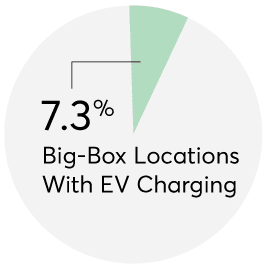
Company
EV Charging
of Store Locations*
Sam’s Club
At the Brooklyn Ikea on a recent Friday, Daniel Hiator, an independent contractor for Amazon, lamented the paucity of chargers in the lot. As he was charging his 2019 BMW X5 plug-in hybrid, which he uses in his work delivering Amazon Fresh packages, two of the other chargers were engaged by cars with New York City-issued Taxi & Limousine Commission license plates, signifying they were vehicles for hire. The third car had a standard license plate and, according to the charger display was fully charged, to Hiator’s annoyance.
“That thing’s been full for 45 minutes already,” he said. “They need way more chargers here.”
Good Chargers Can Be Good Business
The small number of chargers at major retailers is a bit of a surprise, given growing research showing that adding them to parking lots can be good business.
Some stores, for example, place chargers in a paid parking garage. But the real opportunity comes from driving traffic to stores and keeping customers shopping longer. An analysis by the nation’s largest charging network, ChargePoint, found that the amount of time a consumer spent at a store while charging increased by 50 minutes. And an analysis by another charging network, Blink, found that 89 percent of EV drivers make a retail purchase while charging.
A few stores, such as Publix and Stop & Shop supermarkets, find the prospect of luring customers into longer shopping sessions so appealing that they actually offer free charging.
Hiator, the Amazon contractor, does not have a charger at his home and relies entirely on public charging to keep his car humming. He uses an app from ChargePoint to hunt for open chargers all over the city, but the Ikea location is his favorite.
For one thing, it’s near work. Even better: It’s less expensive than the next closest option, a Whole Foods 2 miles away. “It’s about nine dollars an hour to charge here at Ikea, while at the Whole Foods I pay more than $12,” Hiator says. And while he admits he’s never been inside the Whole Foods, he has “stretched his legs” walking around the Ikea.
That’s music to the ears of Scot Case, vice president of corporate social responsibility and sustainability at the National Retail Federation, who also happens to be the proud owner of an electric 2022 Nissan Leaf.
“Early on retailers were happy to install EV chargers because they tended to be for wealthier consumers,” he says, referring to the results of an NRF member survey from 2022. Many leading big-box retailers are members of the organization. “Now our members absolutely want to do anything to appeal to all consumers, as EVs become more widely available and more affordable for everyone.”
Bumps in the Road
There are some issues that keep more retailers from installing charging stations. Referring to convenience retailers like 7-Eleven, and quick-service restaurants with very small parking lots, “you might not actually want someone occupying a parking space for a long period of time,” Case says. He also points out that some retailers do not own the spaces in the parking lots their customers use and are constrained by the property owners’ wishes.
Also, when it comes to making an investment in EV charging, there are situations where business owners may feel the juice isn’t worth the squeeze. For example, in some states the electric utilities not only provide power but also are getting into the retail EV charging business, building their own charging hubs. In 2022, Minnesota’s largest electricity provider, Xcel, filed a proposal with the state to build and operate 730 high-speed EV charging stations. The $170 million price tag will be paid by Xcel’s ratepayers through surcharges added to their electric bills over a four-year period.
“Businesses know they can’t compete with a big utility like Xcel,” says Ryan McKinnon, a spokesperson at Charge Ahead Partnership, a coalition of businesses advocating for the development of privately operated EV charging. ”Businesses are way less likely to spend the hundreds of thousands of dollars that it costs to install EV charging stations if they’re just going to be undercut by their own power company,” he says.
Another problem for retailers: Electric companies can set policies like “demand charges” for commercial accounts, similar to surge pricing applied by rideshare platforms. This can dramatically spike the price of electricity supplied to EV charging sites at retail locations when there is high demand at once, which the retailer would have to either absorb or pass on to customers.
The Rocky Mountain Institute, a nonprofit advocacy organization dedicated to improving America’s energy practices, recommends that state utility regulators limit or eliminate demand charges as a best practice for promoting a business environment conducive to expanding public EV charging. Another possible solution identified in CR’s report: Businesses could install solar technology and on-site battery backup as ways to avoid demand charges from their electric providers.
Tell the Stores You Frequent That You Would Like to See More EV Chargers
Ready to spark change? Together we can pave the way for a future where you won’t have to worry about planning where to charge your car. Let’s fuel progress on EV charging together!
Making the Connection
To overcome some of those barriers, retailers interested in offering EV chargers can also take advantage of some financial incentives offered by the government that would defray the substantial cost of building them. The Inflation Reduction Act provides tax credits of up to 30 percent of the cost of installing EV chargers (up to $100,000 per charger) for qualifying retail store locations.
In the interest of equity, some of the tax credits offered to retailers through the Inflation Reduction Act are earmarked for specific low-income or nonurban census tracts areas, where approximately two-thirds of Americans live. Separately, the Charging and Fueling Infrastructure Grant Program, part of the Bipartisan Infrastructure Law, has a $2.5 billion purse to directly award funding for states and localities to develop chargers along travel corridors and in local communities.
Increased consumer demand and federal funds could be a potent enticement for businesses to install EV chargers, but there are miles to go before the Biden administration’s 2030 goal can be met. Out of 75 companies CR reviewed, only 13 made public commitments regarding the installation of EV chargers. Circle K, H-E-B, Kohl’s, and Northeast Grocery were the only four companies with specified timelines for action that included exact numbers of charging locations to be installed by that date.
Still, Case, at the National Retailer Federation, remains optimistic. “Businesses are transitioning toward electric vehicles where they can, and they are trying to make it easy for the consumer to do the same thing,” he says.
As for Hiator, he has a list of retailers he’d like to see commit to installing EV chargers, including Home Depot and Lowe’s—both of which, CR found, currently offer chargers at less than 1 percent of their locations.
Meanwhile, he remains committed to driving an EV. “It’s the way to go,” he says. “You’re saving the planet, and you’re saving money.”
Retailers who reliably host and maintain chargers might also help take some of the guesswork out of finding a place to plug in. Currently, EV owners must rely on a patchwork of apps and websites—including PlugShare, A Better Route Planner, and navigation systems built into their cars—to locate a charger. But in the future, drivers could simply head to the closest branch of a retailer that offers on-site EV charging.
@consumerreports What if you had a say in where you could publicly charge your #electricvehicle? Tap the link in our bio to tell us which retailer you want to see install more charging stations. Charging an #EV shouldn’t be a barrier to purchasing or owning one. #carsoftiktok #cartok
♬ original sound - Consumer Reports

















